Speak directly to the analyst to clarify any post sales queries you may have.
The metal detector market faces growing complexity, with evolving regulatory standards and new technologies shaping industry strategies. Senior decision-makers require actionable insight to navigate changing landscapes and invest effectively in solutions that safeguard both operations and long-term value.
Metal Detector Market Snapshot: Size, Growth, and Opportunity
The global metal detector market is valued at USD 1.77 billion and is forecast to reach USD 1.94 billion by 2025, reflecting a compound annual growth rate of 10.12%. This growth is driven by rising security demands across public and private sectors, constant advances in detection sensor technology, and broader applications spanning several industries. Suppliers and manufacturers increasingly focus on specialized solutions, adaptable distribution strategies, and closer engagement with end users. Strategic leadership in this market requires agile adaptation to both technological and regulatory developments, as competitors continue to innovate and expand value propositions.
Scope & Segmentation of the Metal Detector Market
A clear segmentation framework allows senior executives to streamline procurement, reduce compliance risk, and customize solutions for evolving operational objectives. Understanding the diversity within the market helps organizations align investments with unique requirements in various contexts.
- Type: Handheld, portable, vehicle-mounted, and walk-through models address detection needs from rapid field screening to secure facility control.
- Technology: Beat frequency oscillation, very low frequency (VLF), and pulse induction support application-specific performance, enabling organizations to match detector capabilities to compliance and functionality requirements.
- Application: Deployment spans archaeological research, mineral exploration, process monitoring, recreational searching, law enforcement, and defense, ensuring both practical utility and regulatory alignment.
- End User: Customized solutions serve financial institutions, retail, event coordination, logistics, customs authorities, military, and public safety agencies, supporting diverse operational mandates.
- Distribution Channel: Online and offline channels facilitate urgent procurement as well as longer-term supply partnerships based on operational priorities or demand cycles.
- Price Range: Various high, medium, and low-price options allow buyers to balance budget requirements with full asset life cycle considerations, promoting strategic purchasing decisions.
- Regions: Market conditions and compliance requirements differ across Americas, Europe, Middle East & Africa, and Asia-Pacific, driving the need for regional approaches and flexibility in go-to-market planning.
Key players—Minelab Electronics Pty Ltd, Garrett Metal Detectors, LLC, and Fisher Research Laboratory, Inc.—actively drive innovation and help shape future sector standards, particularly as regulatory and technology environments continue to evolve.
Key Takeaways for Senior Decision-Makers
- Integrating advanced detection technology with machine learning and modular hardware supports rapid adaptation and ongoing system improvements in line with operational change.
- Ergonomic enhancements in product design deliver greater user comfort and improved efficiency for industrial and field-based activities.
- Digital procurement platforms contribute to faster purchasing cycles and foster greater supply chain reliability, ensuring organizations stay abreast of new technological developments.
- Collaboration between technical, compliance, and logistics teams expedites the rollout of advanced detection systems while improving organizational readiness for regulatory changes.
- Strategic activity, including mergers, acquisitions, and targeted partnerships, gives organizations flexibility to respond effectively to evolving market pressures and sustainability targets.
- Awareness of unique regional regulations enables organizations to anticipate compliance requirements, reduce risks, and maintain operational alignment with global standards.
Tariff Impact: Navigating Trade Policy and Supply Chain Challenges
Recent changes in U.S. tariffs have increased procurement and distribution expenses for metal detector solutions. In response, organizations are updating sourcing practices, optimizing assembly processes, and focusing more on service-based procurement. These adjustments help maintain operational stability, dampen the impact of regulatory shifts, and bolster resilience within supply chains.
Methodology & Data Sources
Findings are based on executive interviews, detailed reviews of current technological and regulatory trends, and organizational case studies. This integrated approach delivers credible, actionable insight to inform strategic purchasing and operational decisions for market leaders.
Why This Report Matters
- Empowers executives to address changing technology trends and global supply chain complexity, supporting consistent operational strength for their organizations.
- Offers practical advice for maintaining regulatory compliance in varied jurisdictions, enabling more flexible and robust procurement strategies.
- Provides a comprehensive market perspective, equipping senior leaders with essential guidance for effective, data-driven investment and planning decisions.
Conclusion
Building leadership in the metal detector market requires proactive technology adoption and effective compliance management. This report provides senior executives with the clarity needed for strategic decisions that sustain organizational resilience and long-term value.
Additional Product Information:
- Purchase of this report includes 1 year online access with quarterly updates.
- This report can be updated on request. Please contact our Customer Experience team using the Ask a Question widget on our website.
Table of Contents
3. Executive Summary
4. Market Overview
7. Cumulative Impact of Artificial Intelligence 2025
Companies Mentioned
The companies profiled in this Metal Detector market report include:- Minelab Electronics Pty Ltd
- Garrett Metal Detectors, LLC
- Fisher Research Laboratory, Inc.
- Nokta Makro Detectors, Inc.
- XP Metal Detectors SAS
- C.Scope International Ltd
- White's Electronics, Inc.
- Tesoro Enterprises, Inc.
- Deteknix Pty Ltd
- Explorer Metal Detectors, Inc.
Table Information
| Report Attribute | Details |
|---|---|
| No. of Pages | 195 |
| Published | October 2025 |
| Forecast Period | 2025 - 2032 |
| Estimated Market Value ( USD | $ 1.94 Billion |
| Forecasted Market Value ( USD | $ 3.82 Billion |
| Compound Annual Growth Rate | 10.1% |
| Regions Covered | Global |
| No. of Companies Mentioned | 11 |









